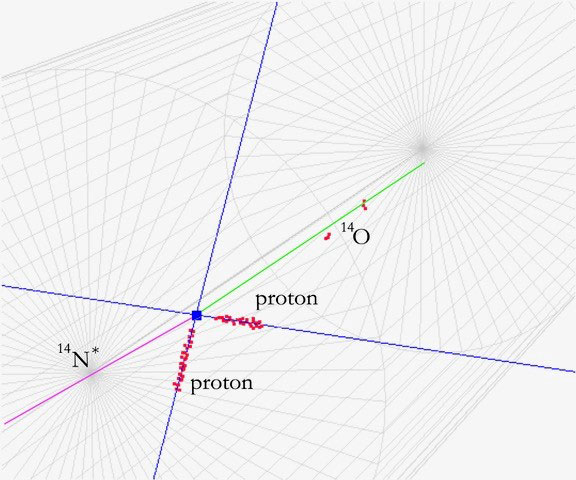The Science
The nuclear reactions that power stellar explosions involve short-lived nuclei that are hard to study in the laboratory. To solve this challenge, researchers used a novel technique that combines an Active Target Time Projection Chamber (AT-TPC) with a magnetic spectrometer. The AT-TPC detects and identifies particles by tracing their track as they move through a space filled with gas. The magnetic spectrometer collects and identifies particles that leave this gas-filled area. They used this technique to measure an important reaction where a neutron from a deuterium target is exchanged with a proton from a radioactive projectile, in this case oxygen-14. This type of reaction is equivalent to the electron-capture process that happens in explosions of massive stars and other astronomical phenomena. Scientists will use the results from this new type of experiment to model these events. This will help researchers better understand how these events shape the universe and the elements we find on Earth.
The Impact
This first successful measurement opens the door to future work on short-lived isotopes that are important for understanding astronomical phenomena. The reactions that this technique can study affect the evolution of exploding stars and the elements they produce. Future studies will help answer one of the fundamental questions of nuclear physics, the origin of the elements. The combination of the Active Target technique with a magnetic spectrometer will allow researchers to probe radioactive nuclei and model their behavior in stellar environments.
Summary
At the National Superconducting Cyclotron Laboratory (now the Facility for Rare Isotope Beams or FRIB), researchers used the Active Target Time Projection Chamber coupled to the S800 magnetic spectrometer to measure a charge-exchange reaction between a radioactive oxygen-14 beam and a deuterium target. This type of measurement is now possible thanks to the high luminosity and sensitivity of the Active Target technique, where the target material (here deuterium gas) also acts as a detector medium. The radioactive oxygen-14 beam was produced by the Coupled Cyclotron Facility and injected in the AT-TPC filled with deuterium gas. The two low-energy protons resulting from the reaction were detected from their characteristic tracks, while the nitrogen-14 escaped the target volume and was detected by the S800 spectrometer. This type of measurement was previously impossible because of the very low energies of the protons after the reaction, making them very difficult to observe when using a solid target.
By using the AT-TPC, researchers are now able to measure this reaction on other short-lived isotopes available at FRIB. This work was performed by a collaboration of scientists from Michigan State University, the University of Santiago in Spain, the University of Mainz in Germany, Argonne National Laboratory, and Oak Ridge National Laboratory.
Contact
Daniel Bazin
Facility for Rare Isotope Beams
bazin@frib.msu.edu
Funding
This material is based upon work supported by the Department of Energy Office of Science, Office of Nuclear Physics, the National Science Foundation, and the Joint Institute for Nuclear Astrophysics.
Publications
S. Giraud et al., ß+ Gamov-Teller Strengths from Unstable 14O via the (d, 2He) Reaction in Inverse Kinematics. Physical Review Letters 130, 232301 (2023). [DOI: 10.1103/PhysRevLett.130.232301]
S. Giraud et al., Simulations and analysis tools for charge-exchange (d, 2He) reactions in inverse kinematics with the AT-TPC. Nuclear Instruments and Methods in Physics Research Section A 1051, 168213 (2023). [DOI: 10.1016/j.nima.2023.168213]
J. Bradt et al., Commissioning of the Active-Target Time Projection Chamber. Nuclear Instruments and Methods in Physics Research Section A 875, 65 (2017). [DOI: 10.1016/j.nima.2017.09.013]
Scraped from https://www.sourcearu.com
